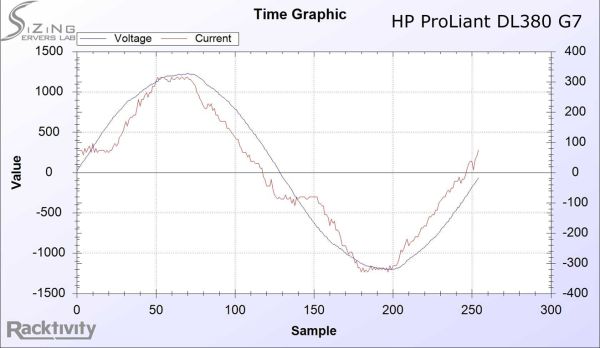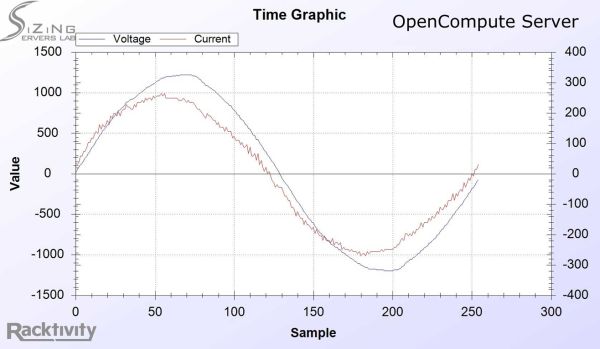Facebook's "Open Compute" Server tested
by Johan De Gelas on November 3, 2011 12:00 AM ESTPower Supply Efficiency Visualized
I graduated as an electromechanical engineer, but 17 years of IT jobs and research have helped me forget a lot about electricity and electronics. However, I have the advantage of running the Sizing Servers Lab (at the university college of West-flanders, Howest) and thus the privilege of working with some very talented people. Tijl Deneut told me he would be able to visualize the efficiency of the power supply. So with the advanced Racktivity PDU, he managed to produce a time graphic that shows how close the current sine wave remains to to the voltage sine wave. If the two are perfectly in phase, the power quality or power factor is 100%.
In your own home, this power factor is less important. However, large installations such as a data centers have to pay extra for bad power factors as a low power factor causes the electrical system to draw more current for the same amount of work being done, and more current results in higher heat losses.
Data centers have large power factor correctors, electronic systems with large capacitors that improve the PF but also consume energy. A bad PF can increase the Power Usage Effectiveness (PUE) of the data center, and this PUE has become an extremely important "benchmark" for data centers. The less these systems have to work the better, so the PF of a server PSU should be as close to 1 as possible.
We started by measuring while the server is close to idle, which is a pretty bad scenario for the PF. First let's look at the sine waves of the HP DL380 G7:
That's not bad at all, but next let's look at the sine waves of the AC that enters the Open Compute server
The current sine wave is not only closer to the voltage sine wave, it is also much closer to the ideal form of an AC sine wave, which makes energy delivery more efficient. It is one of the first indications that the Facebook engineers did their homework very well.












67 Comments
View All Comments
fpsvash - Thursday, November 3, 2011 - link
In the middle of the paragraph below the image caption, the sentence reads "...and offers better slightly better performance..."Other than that, nice post!
ahmetmy330 - Thursday, December 29, 2016 - link
this is my university work about open servers. Thanks for posthttp://www.h2kjamaica.com/maddenmobilehack/
InternetGeek - Thursday, November 3, 2011 - link
It's interesting that no many players have taken a look at Open Compute.alent1234 - Thursday, November 3, 2011 - link
it's a solution for a specific workload. there are still a lot of workloads that require the traditional model of big database serversunlike your bank, facebook's noSQL is not ACID
FunBunny2 - Saturday, November 5, 2011 - link
Well, yes a voice of reason. OTOH, the Facebook et al folks are convinced that their back to the COBOL era is the future. As if a toy application, albeit pervasive, is "innovation".Sivar - Saturday, November 5, 2011 - link
It's a little difficult to look at a comment about Facebook being a toy application and take it seriously. Yes, Facebook is not directly processing bank transactions on a Tandem, but their site is used to conduct business -- and is even the basis for many businesses, all over the world.Zynga, the company that makes a few annoying games for Facebook, is worth $15 -- more than Electronic Arts.
Nearly every major online publisher, including Anandtech, uses their API for content distribution and often as the entire forum system for discussion of publications.
The founder is the youngest billionaire in history.
Calling theirs a toy application sounds like a Blockbuster customer calling Redbox a toy. It's denial of an obviously successful, large, powerful, innovative company because they don't do things "the old way."
I suspect what matters more is that the business is executing flawlessly, the actual problems with data loss or other non-ACID compliant traditional issues are minimal, and that they are making enough money that Google and Microsoft are feel seriously threatened.
One last thing -- if you really look into what ACID compliance means (and I know you did not specifically mention the acronymn, but replied to someone that did) none of the current major DBMS's are truly ACID compliant. It's too slow. Not Oracle. Not MSSQL. Not Greenplum. Not Teradata. None of them. They may be closer than NoSQL or the like, but then it's all about the right tool for the job, right?
Ceencee - Wednesday, November 9, 2011 - link
This is true but ACID can be over-rated for many workloads. How many pieces of data HAVE to be consistent across the entire cluster to be valid? What about NoSQL with configurable consistency like Cassandra?NoSQL databases provide the holy grail of system growth which is horizontal scaling and this is no small thing for anyone who has worked with a very large RDBMS like ORACLE and implemented RAC to find it doesn't scale all that linearly for most workloads.
ahmetmy330 - Sunday, January 1, 2017 - link
ctually i assume you might have actually stumble upon these dubious <a href="http://www.h2kjamaica.com/bowlingkinghack/"&g... King cheats </a>programs and software packages downloads but are convinced usahmetmy330 - Thursday, January 12, 2017 - link
http://www.onslow.us/8ballpoolhack/I have told you
ac2 - Thursday, November 3, 2011 - link
Wouldn't the presence of the graphics on the HP server account for the 32W idle load savings?